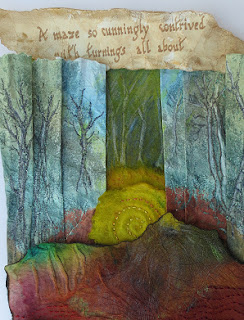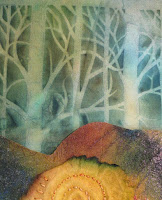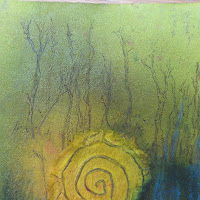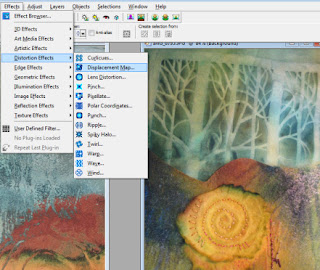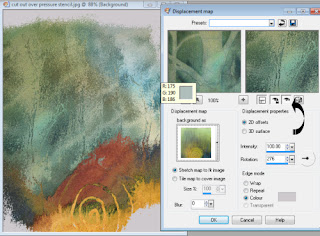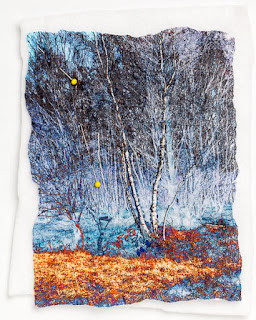Here I am again – just when you all thought I’d gone for
good. I do have valid reasons for the non-writing of the blog for much of this
year. There are so many excuses in fact, that I could offer you a bullet list! You have already heard some of them but I am determined to extract the maximum amount of sympathy so I'm listing them all! If
you wish to escape my hard luck story, skip to here ***.
Here is a pretty pic of a detail of some recent work to keep you going.
It has been a dispiriting year for many small businesses;
beginning with the EU inspired digital VAT disaster. This was aimed at collecting
overseas VAT from mega businesses selling online but most of those have managed
to evade it while the smaller ones – such as one person selling knitting
patterns – was caught in a bureaucratic nightmare that saw
many small businesses ceasing trading.
We had no sooner got over that than the company that
organises our credit card facilities for WoW and D4daisy changed some ‘protocols’
involving costly and time consuming work. As a result of these requirements, we
took the opportunity to restructure Workshop on the Web and that took months of
‘deeds of variation’ and form filling.
However it did involve both Fiona and Sam taking a more
in-depth role and that perked WoW up immensely. With a member-only blog and
Facebook page, we now have lots of extra content, with more workshops and
product reviews, kits for the workshops and lots of contact with members. We love
to see their work, which is classy stuff, as you can see from this pic by Mardi
Robson, based on a Lynda Monk workshop.
That was a popular kit, which included one of Lynda’s
silkscreens. We even have the odd video. All this has resulted in increased
subscriptions so WoW is safe once more.
I think everything is on an even keel again now but I have
felt as though much of this year has been spent tied to a desk or a telephone
and it was all rather depressing. In the end we have a better business model
and are more secure, so there is a silver lining.
***I have been able to get in enough stitching to produce a
new book, due out shortly. It was supposed to be out in February/March but the
work was getting finished much more quickly than expected so we decided to make
a monumental effort and publish before Christmas. It’s at the printers so
should be around next week sometime. I have so enjoyed working on it as I have
taken a new direction, with a theme of diaries and story-telling.
WoWies will recognise my long diary, subject of an article a
while ago. I had so much feedback that it prompted me to explore the theme
further in a book. It’s the story-telling that has really got me hooked and I have
been working on a theme of Myth and Legend. In addition to my own textiles, I have
included work by some of my friends and they have turned into characters in the
book. Here you can see a wonderful oil pastel work by my good friend Jane Wild.
This chap became the hero of a tale about a band of travellers,
seeking Peace Island to bring peace to the world. God knows that we need it
right now.
He rather took over the story, which resulted in a
completely different direction to the one I had planned, but he did engineer a
happy ending. It was a good ending for me too as Jane has given him to me, so I
shall get him framed very soon. I intend to pursue this theme of fantasy
through several more pieces of work and make some illustrated stitched books.
As usual there are lots of techniques one of which involves
making pressure stencilled patterns on silk. I spoke about this in my last blog but have developed more ideas. Val Campbell-Harding and I did
this for a book once, but I’ve developed it further. The beginning is very
simple – you just paint a piece of silk and, while wet, place a plastic stencil
on top. As this was for a piece about a mythical wood, I used a Clarity stencil
tree design. Putting a weight over the stencil as it dries caused interesting
effects.
 I have then scanned the resulting pattern into a paint program
and worked on it by changing the colours and highlighting different areas. Such fun
and I shall be putting ‘how I do it’ posts on here and the d4daisy books web
site when the book is out.
I have then scanned the resulting pattern into a paint program
and worked on it by changing the colours and highlighting different areas. Such fun
and I shall be putting ‘how I do it’ posts on here and the d4daisy books web
site when the book is out.
I am really excited about continuing the theme and, as I
have an exhibition coming up at Art Van Go in March and a ‘progress’ to
Scotland in April, there will be chances to show the work. I shall also be at
Craft4crafters in Exeter in February – a busy time ahead.
Now the book is done there is a lot of catching up for
Christmas so I’m off to hit the shops. Tomorrow our unaccompanied singing group,
‘Local Vocals’, is performing at the local stately home so we will be feeling
very Christmassy after that.
I will be back soon, I promise – I’ll need to tell you when
the book is here!
 I don't hang out here much these days as I write most of my news on my Chez Grey website www.workshopontheweb.com/chezgrey.
I don't hang out here much these days as I write most of my news on my Chez Grey website www.workshopontheweb.com/chezgrey.
